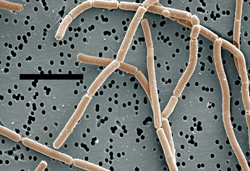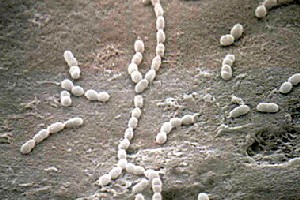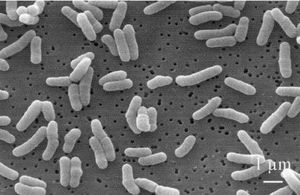Swiss Cheese Niche: Difference between revisions
| Line 66: | Line 66: | ||
===Effects of strains and growth conditions on autolytic activity and survival to freezing and lyophilization of ''Lactobacillus delbrueckii ssp. lactis'' isolated from cheese=== | ===Effects of strains and growth conditions on autolytic activity and survival to freezing and lyophilization of ''Lactobacillus delbrueckii ssp. lactis'' isolated from cheese=== | ||
There has been a correlation between the autolytic activity of Lactobacillus and the survivability of other organisms within cheese, specifically the viability of Streptococcus thermophilus. However there is very little information and insufficient research to actually link the two together. This study further examines the autolysis of Lactobacillus when growth conditions are varied between room temperature and freezing. Certain strains of Lactobacillus were used due to their nature to have a higher sensitivity in hasher treatment conditions to be able to determine if certain factors will change their survival rates. The study | There has been a correlation between the autolytic activity of Lactobacillus and the survivability of other organisms within cheese, specifically the viability of Streptococcus thermophilus. However there is very little information and insufficient research to actually link the two together. This study further examines the autolysis of Lactobacillus when growth conditions are varied between room temperature and freezing. Certain strains of Lactobacillus, specifically L. delbrueckii, were used due to their nature to have a higher sensitivity in hasher treatment conditions to be able to determine if certain factors will change their survival rates. The study goes on to control the pH levels and aeration in addition to temperature. Lactobacillus' ability to adapt and change to survive at a range of temperatures and how effective it is at each of those steps is what this study tries to address. The conclusion gained from this study was that while survivability was good at almost freezing temperatures, viability after lyophilization showed significant losses. However, adding acidic pH will induce a stress-like state for the Lactobacillus which increased the viability after lyophilization. | ||
===Interaction between propionibacteria and starter /non-starter lactic acid bacteria in Swiss-type cheeses=== | ===Interaction between propionibacteria and starter /non-starter lactic acid bacteria in Swiss-type cheeses=== | ||
Revision as of 02:42, 29 August 2008
Description of Swiss Cheese
Where located?
Physical Conditions?
What are the conditions in your niche? Temperature, pressure, pH, moisture, etc.
Influence by Adjacent Communities (if any)
Is your niche close to another niche or influenced by another community of organisms?
Conditions under which the environment changes
Do any of the physical conditions change? Are there chemicals, other organisms, nutrients, etc. that might change the community of your niche.
Who lives there?
Which microbes are present?
Within the Swiss Cheese environment lives three types of microbes of the genus lactobacillus, streptococcus, and propionibacteria.


Lactobacillus
Lactobacillus is a homofermentative, thermophilic and gram-positive bacteria that is always found within Swiss cheese due to its ability to provide texture and sharpness of the cheese. Different types of strains of lactobacillus(L. helveticus, L. casei, L. bulgaricus) live in Swiss cheese but the more commonly known bacteria is the strain lactobacills helveticus. This microbe is part of the lactic acid family of bacteria by converting lactose present in the cheese to lactic acid. [1]
Streptococcus thermophilus
Streptococcus thermophilus is a homofermentative and gram-positive lactic acid bacterium responsible for the initial lactate fermentation of Swiss cheese. S. Thermophilus is responsible for the acidity and texture in the cheese’s early production and the conversion of casein into nitrogen sources. (The thermophilic bacteria is ideal for its ability to survive the initial heating of milk.) Streptococcus is a common starting culture found in milk products. S. thermophilus is often utilized in Cheddar cheese, Italian cheeses, and yogurt.[a]
Propionibacterium Shermanii
Propionibacterium Shermanii is a slow growing and gram positive bacterium that grows in an anaerobic glucose medium. P. shermanii is responsible for producing the holes and the distinct flavor of Swiss cheese. The growth rate of the bacterium is dependent on the surrounding temperature, pH, and bacteria. The optimal growth for P. shemanii is in warm temperature and at a pH of 5.3. The bacterium’s growth is also dependent of the availability of lactic acid which is produced by L. helveticus and S. thermophilus. [10]
Do the microbes that are present interact with each other?
L. helveticus and S. thermophilus
Lactobacillus helveticus is mainly involved with Streptococcus thermophilus in controlling the pH level of the Swiss cheese environment through their fermentation of lactose. The Swiss cheese enivronment changes temperatures due to the pastuerization process and in its intial stages Streptococcus thermophilus is the more dominant bacteria in the cheese. However since makers of Swiss cheese allow it to sit at room temperature for the ripening process allows for the growth of Lactobacillus helveticus. Since room temperature is slightly off from the optimum growth temperature which is around 45 degrees Celcius for Lactobacillus helveticus, the microbe is slowly able to grow. When L. helveticus reaches its maximum growth or reaches the stationary phase it begins to autolyse and starts to affect the viability of Streptococcus thermophilus. There is correlation between the survivability of Lactobacillus and Streptococcus but there are no specifics as to why the correlations occur. [2]
The specifics of the symbiotic relationship between S. thermophilus and L. helveticus rely mainly on Lactobacilus’s strong proteolytic system. Lactobacilus’ proteolytic enzymes liberate milk protein casein into smaller peptides and amino acids that serve as peptide substrates for S. thermophilus’ aminopeptidases. The growth of L. helveticus is stimulated by formic acid and carbon dioxide production of S. thermophilus.[6][8]
P. Shermanii
The growth of P. Shermanii is heavily dependent on L. helveticus and S. thermophilus. Since low pH level does not favor growth for P. Shermanii, the ability of L. helveticus and S. thermophilus to change the pH of the niche determines the population size of P. Shermanii. Additionally, the bacterium relies on L. helveticus and S. thermophilus to produce lactic acid for it to consume. If lactic acid is not present, P. Shermanii can still survive by consuming lactose but the growth rate of the bacterium will be slower. [10]
Do the microbes change their environment?
Do they alter pH, attach to surfaces, secrete anything, etc. etc.
S. thermophilus and Lactobacillus are responsible for the increase in pH and the coagulation of casein during lactic acid fermentation. The increase in acidity as a consequence of the proteolytic microbes contribute to the cheese's distinct flavor, texture, and composition.
[5]
The decrease in pH is attributed to the utilization of lactose and galactose during early stages of Swiss cheese manufacture. S. thermophilus and Lactobacillus alter the pH by fermenting the lactose that surrounds them and converting it into lactic acid. In addition to changing their environment Lactobacillus can also produce formation of lactate calcium crystals and toxic amines. The lactate calcium crystals form on the surfaces on the cheese and has no adherent effects on the Lactobacillus and is just a defect within the cheese environment. No information or study has been found yet on how the production of toxic amines would affect the surrounding microbes of Streptococcus and Propionibacteria but was more commonly known as an outbreak of food poisoning when ingested by humans. [3][4]
Do the microbes carry out any metabolism that affects their environment?
Do they ferment sugars to produce acid, break down large molecules, fix nitrogen, etc. etc.
Along with Lactobacillus, S. thermophilus is responsible for the proteolytic activity of lactose in lactic acid fermentation. Since S. thermophilus is only weakly proteolytic compared to Lactobacillus, it aids the aminopeptidase producing bacteria through their symbiotic relationship. Both of these primary microbes produce other metabolites such as acetaldehyde, diacetyl, and ethanol released into the Swiss cheese.[3] Lactobacillus' autolytic activity and release of intracellular enzymes such as peptidases or lipases or enzymes from amino acid catabolism has effected the viability of other bacterias in Swiss cheese. These starter cultures possess lactose-hydrolyzing proteins
P. Shermanii consumes the lactic acid that is excreted by L. helveticus and S. thermophilus in the Swiss cheese and release carbon dioxide gas and propionic acid via fermentation. The carbon dioxide stays in the cheese in forms of bubbles which make the holes of the Swiss cheese. The propionic acid contributes to the Swiss cheese’s characteristic flavor. [9]
Current Research
Resistance to Freezing and Frozen Storage of Streptococcus thermophilus Is Related to Membrane Fatty Acid Composition
S. thermophilus’s ability to resist freezing and frozen storage was examined under four experimental factors and quantified by the ability to regain acidification activity of the lactic acid bacteria. The four experimental factors observed include: concentration of fatty acid with storage time, addition of glycerol as a cyroprotective agent, addition of oleic acid, and fermentation pH. The lactic acid bacteria was grown at 42C until the beginning of stationary phase at which experimental conditions were implemented. The acidification activity was measured before, after and during storage with the Cinac System. Experimental results show recovery of acidification activity of S. thermophilus with observable changes in membrane fatty acid composition with the experimental factors: increase in unsaturated fatty acid concentration with storage time, increase in unsaturated:saturated fatty acid ratio with addition of oleic acid and pH fermentation, but no effect in the addition of glycerol. The adaptation in unfavorable pH triggered a homeostatic mechanism that affected transbilayer movement of phospholipids and maintained permeability of membrane. The dependence of fermentation pH and oleic acid in unsaturated:saturated ratio still remains unclear [7]
Effects of strains and growth conditions on autolytic activity and survival to freezing and lyophilization of Lactobacillus delbrueckii ssp. lactis isolated from cheese
There has been a correlation between the autolytic activity of Lactobacillus and the survivability of other organisms within cheese, specifically the viability of Streptococcus thermophilus. However there is very little information and insufficient research to actually link the two together. This study further examines the autolysis of Lactobacillus when growth conditions are varied between room temperature and freezing. Certain strains of Lactobacillus, specifically L. delbrueckii, were used due to their nature to have a higher sensitivity in hasher treatment conditions to be able to determine if certain factors will change their survival rates. The study goes on to control the pH levels and aeration in addition to temperature. Lactobacillus' ability to adapt and change to survive at a range of temperatures and how effective it is at each of those steps is what this study tries to address. The conclusion gained from this study was that while survivability was good at almost freezing temperatures, viability after lyophilization showed significant losses. However, adding acidic pH will induce a stress-like state for the Lactobacillus which increased the viability after lyophilization.
Interaction between propionibacteria and starter /non-starter lactic acid bacteria in Swiss-type cheeses
Studies showed that Swiss-type cheeses shared three fundamental bacteria: thermophilic lactic acid bacteria, propionibacteria, and heterofermentative lactobacilli. In 2002 the Swiss Dairy Research Station inspected the bacteria’s interactions and their influence on the quality and late fermentation of the cheese. Multiple emmental cheeses were used as models for this project. These models were separated in four factors. The aspartase activity strength in different cultures of propinoibacteria, the presence of Lactobacillus casei strains, the presence of Lactobacillus helveticus strains, and the season, winter and summer. The research discovered that the strength of aspartate metabolism in propionibacteria is correlated to their growth rate and propinoic acid fermentation. The propinoibacteria’s growth is also greater in winter than in the summer. In addition, it was found that the defect of late fermentation can be stopped by the presence of L. casei and weak aspartase activity in propionibacteria and the absence of L. helveticus. However, the study was not able to determine whether the aspartase metabolism is the activator or indicator of propionibacteria’s growth and fermentation. Future studies will focus on this particular area in order to further understand the effect of propionibacteria in Swiss-like cheeses. [11]
References
[4] Hutkins, R., Halambeck, S. M., Morris, H. A. Use of Galactose-Fermenting Streptococcus thermophilus in the Manufacture of Swiss, Mozzarella, and Short-Method Cheddar Cheese J. Dairy Sci. 1986 69: 1-8
[5] Rajagopal, S. N., Sandine, W. E. Associative Growth and Proteolysis of Streptococcus thermophilus and Lactobacillus bulgaricus in Skim Milk J. Dairy Sci. 1990 73: 894-899
[6] Rul, Francoise, Monnet, Veronique, Gripon, Jean-Claude Purification and Characterization of a General Aminopeptidase (St-PepN) from Streptococcus salivarius ssp. thermophilus CNRZ 302 J. Dairy Sci. 1994 77: 2880-2889
[7] Beal, C., Fonseca, F., Corrieu, G. Resistance to Freezing and Frozen Storage of Streptococcus thermophilus Is Related to Membrane Fatty Acid Composition. J. Dairy Sci. 2001 84: 2347-2356
[8] Louaileche, Hayette, Bracquart, Patrice, Saulnier, Franck, Desmazeaud, Michel, Linden, Guy Carbon Dioxide Effects on the Growth and Metabolites of Morphological Variants of Streptococcus thermophilus J. Dairy Sci. 1993 76: 3683-3689
[9] Keenan, T. W., Bills, D. D. Volatile Compounds Produced by Propionibacterium shermanii J. Dairy Sci. 1968 51: 797-799
[10] Kurtz, F.E., Hupfer J. A., Corbin E. A., Hargrove R. E., Walter H. E. Interrelationships Between pH, Populations of Propionibacterium Shermanii~ Levels of Free Fatty Acids, and the Flavor Rating of Swiss Cheese J. Dairy Sci. 1959 42: 1008-1019
[11] Frohlich-Wyder, M., Bachmann, H., Casey, M. Interaction between propionibacteria and starter /non-starter lactic acid bacteria in Swiss-type cheeses EDP Sciences, 2002
Edited by Heidi Cung, Derrick Low, Binh Phung, and Danny Tran, students of Rachel Larsen

